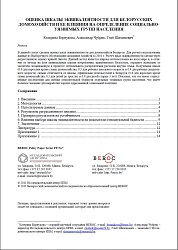Оценка шкалы эквивалентности для Белорусских домохозяйств и ее влияния на определение социально-уязвимых групп населения
Assessment of the Equivalence Scale for Belarusian Households and its Influence on Determining socially vulnerable Population Groups
Author(s): Kateryna Bornukova, Aleksandr Chubrik, Gleb Shymanovich
Subject(s): Applied Sociology, Health and medicine and law, Family and social welfare
Published by: BEROC Belarusian Economic Research and Outreach Center
Keywords: Belarus; economy;
Summary/Abstract: This article evaluates the equivalence scales for households in Belarus. For the calculation, data from the Household Sample Survey for 2010 were used. The equivalence scales were calculated through the regression estimation of the Engel curve. This method is widely used around the world and, in contrast to the minimum consumption basket method used by Belstat, reflects economies of scale that arise in the process of optimal distribution of expenses within the family. The resulting scale (0.6 for adults other than the head of household, 0.5 for a school-age child and 0.4 for a pre-school child) is very different from the scale officially used in Belarus (0.8 for adults other than the head of household, 0.5 for children under three years of age and 0.9 for children over 3 years). It is shown that this has significant implications for assessing the relative poverty of certain vulnerable groups of the population, which is of great importance for the development of a well-targeted social policy.
Series: BEROC Policy Paper Series
- Page Count: 14
- Publication Year: 2011
- Language: Belarusian
- Content File-PDF

